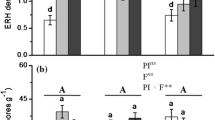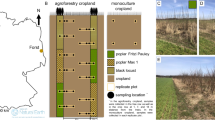Abstract
Background and aims
Pecan truffles (Tuber lyonii) have high commercial value and the potential to be produced in a dual-cropping system with pecan. However, little is known about the linkages among ectomycorrhizal (ECM) fungal diversity, community structure, and environmental factors in pecan orchard ecosystems. Our aim is to investigate how soil pH and other edaphic factors influence the richness and composition of ECM fungi.
Methods
We characterized the soil factors and ECM fungal community associated with pecan and adjacent native trees with 454 pyrosequencing at a regional scale, and tested whether the effects of pH and soil factors altered the ECM fungal communities.
Results
Overall ECM fungal diversity associated with pecan trees was high and about a third of all taxa were shared with native trees adjacent to orchards. The community structure was correlated significantly with soil variables including K, Ca, Mg, Mn, P, Zn and soil pH, but not organic matter. Soil pH was positively correlated with species diversity in the /tuber-helvella, /galactinia, /pachyphloeus-amylascus, and /pisolithus-scleroderma lineages.
Conclusions
pH and soil factors play a key role in regulating the ECM fungal communities in pecan orchards. The frequency and abundance of the pecan truffle and related species is positively and significantly correlated with higher soil pH.






Similar content being viewed by others
References
Abarenkov K, Nilsson RH, Larsson KH, Alexander IJ, Eberhardt U, Erland S, Høiland K, Kjøller R, Larsson E, Pennanen T (2010) The UNITE database for molecular identification of fungi – recent updates and future perspectives. New Phytol 186:281–285
Amend AS, Seifert KA, Bruns TD (2010) Quantifying microbial communities with 454 pyrosequencing: does read abundance count? Mol Ecol 19:5555–5565. doi:10.1111/j.1365-294X.2010.04898.x
Bakker M, Garbaye J, Nys C (2000) Effect of liming on the ectomycorrhizal status of oak. For Ecol Manag 126:121–131
Belfiori B, Riccioni C, Tempesta S, Pasqualetti M, Paolocci F (2012) Comparison of root-associated communities of natural and cultivated Tuber melanosporum truffle grounds. FEMS Microbiol Ecol 81:547–561. doi:10.1111/j.1574-6941.2012.01379.x
Bengtsson-Palme J, Ryberg M, Hartmann M, Branco S, Wang Z, Godhe A, Wit P, Sánchez-García M, Ebersberger I, Sousa F (2013) Improved software detection and extraction of ITS1 and ITS2 from ribosomal ITS sequences of fungi and other eukaryotes for analysis of environmental sequencing data. Methods Ecol Evol 4:914–919
Benucci GM, Bonito G, Falini LB, Bencivenga M (2012) Mycorrhization of pecan trees (Carya illinoinensis) with commercial truffle species: Tuber aestivum Vittad. and Tuber borchii Vittad. Mycorrhiza 22:383–392. doi:10.1007/s00572-011-0413-z
Bonito G, Brenneman T, Vilgalys R (2011) Ectomycorrhizal fungal diversity in orchards of cultivated pecan (Carya illinoinensis; Juglandaceae). Mycorrhiza 21:601–612. doi:10.1007/s00572-011-0368-0
Bonito G, Smith ME, Brenneman T, Vilgalys R (2012) Assessing ectomycorrhizal fungal spore banks of truffle producing soils with pecan seedling trap-plants. Plant Soil 356:357–366
Bonito G, Reynolds H, Robeson MS, Nelson J, Hodkinson BP, Tuskan G, Schadt CW, Vilgalys R (2014) Plant host and soil origin influence fungal and bacterial assemblages in the roots of woody plants. Mol Ecol 23:3356–3370
Caporaso JG, Kuczynski J, Stombaugh J, Bittinger K, Bushman FD, Costello EK, Fierer N, Pena AG, Goodrich JK, Gordon JI (2010) QIIME allows analysis of high-throughput community sequencing data. Nat Methods 7:335–336
Dennis J (1985) Effect of pH and temperature on in vitro growth of ectomycorrhizal fungi. Pacific Forestry Centre. Canadian Forestry Service Information Report BC-X
Edgar RC, Haas BJ, Clemente JC, Quince C, Knight R (2011) UCHIME improves sensitivity and speed of chimera detection. Bioinformatics 27:2194–2200
Fox MD, Tackaberry LE, Drouin P, Bergeron Y, Bradley R, Massicotte HB, Chen HYH (2013) Microbial community structure of soils under four productivity classes of aspen forests in northern British Columbia. Écoscience 20:264–275. doi:10.2980/20-3-3611
Gao C, Shi NN, Liu YX, Peay KG, Zheng Y, Ding Q, Mi XC, Ma KP, Wubet T, Buscot F et al (2013) Host plant genus-level diversity is the best predictor of ectomycorrhizal fungal diversity in a Chinese subtropical forest. Mol Ecol 22:3403–3414
Garcia MO, Smith JE, Luoma DL, Jones MD (2016) Ectomycorrhizal communities of ponderosa pine and lodgepole pine in the south-central Oregon pumice zone. Mycorrhiza 26:275–286
Gardea AA, Martínez-Téllez MA, Yahia EM (2011) Pecan (Carya illinoiensis (Wangenh.) K. Koch.). In: Yahia EM (ed) Postharvest biology and technology of tropical and subtropical fruits. Woodhead Publishing Ltd, Cambridge pp 143–165, 166e.
Gryndler M, Šmilauer P, Šťovíček V, Nováková K, Hršelová H, Jansa J (2017) Truffle biogeography—a case study revealing ecological niche separation of different Tuber species. Ecol Evol 00:1–14. doi:10.1002/ece3.3017
Hall IR, Brown GT, Zambonelli A (2008) Taming the truffle: the history, Lore, and Science of the ultimate mushroom. JSTOR
Hanlin RT, Wu M, Brenneman TB (1989) The occurrence of Tuber texense in Georgia. Mycotaxon 34:387–394
Hardin G (1960) The competitive exclusion principle. Science 131:1292–1297
Heimsch C (1958) The first recorded truffle from Texas. Mycologia 50:657–660
Hill MO (1973) Diversity and evenness: a unifying notation and its consequences. Ecology 54:427–432
Horton BM, Glen M, Davidson NJ, Ratkowsky D, Close DC, Wardlaw TJ, Mohammed C (2013) Temperate eucalypt forest decline is linked to altered ectomycorrhizal communities mediated by soil chemistry. For Ecol Manag 302:329–337. doi:10.1016/j.foreco.2013.04.006
Iotti M, Lancellotti E, Hall I, Zambonelli A (2010) The ectomycorrhizal community in natural Tuber borchii grounds. FEMS Microbiol Ecol 72:250–260
Jumpponen A, Jones KL (2010) Massively parallel 454 sequencing indicates hyperdiverse fungal communities in temperate Quercus macrocarpa phyllosphere. New Phytol 184:438–448. doi:10.1111/j.1469-8137.2009.02990.x
Kjøller R, Clemmensen KE (2009) Belowground ectomycorrhizal fungal communities respond to liming in three southern Swedish coniferous forest stands. For Ecol Manag 257:2217–2225
Kluber LA, Carrino-Kyker SR, Coyle KP, DeForest JL, Hewins CR, Shaw AN, Smemo KA, Burke DJ (2012) Mycorrhizal response to experimental pH and P manipulation in acidic hardwood forests. PLoS One 7:e48946
Kõljalg U, Nilsson RH, Abarenkov K, Tedersoo L, Taylor AF, Bahram M, Bates ST, Bruns TD, Bengtsson-Palme J, Callaghan TM (2013) Towards a unified paradigm for sequence-based identification of fungi. Mol Ecol 22:5271–5277
Lim S, Berbee ML (2013) Phylogenetic structure of ectomycorrhizal fungal communities of western hemlock changes with forest age and stand type. Mycorrhiza 23:473–486. doi:10.1007/s00572-013-0488-9
Marzolo G (2015) Pecans. 2017 Ag Marketing Resource Center, Iowa State University. http://www.agmrc.org/commodities-products/nuts/pecans/. Accessed 12 June 2017
Peay KG, Kennedy PG, Davies SJ, Tan S, Bruns TD (2010) Potential link between plant and fungal distributions in a dipterocarp rainforest: community and phylogenetic structure of tropical ectomycorrhizal fungi across a plant and soil ecotone. New Phytol 185:529–542
Peintner U, Iotti M, Klotz P, Bonuso E, Zambonelli A (2007) Soil fungal communities in a Castanea sativa (chestnut) forest producing large quantities of Boletus edulis sensu lato (porcini): where is the mycelium of porcini? Environ Microbiol 9:880–889
Petersen PM (1985) The ecology of Danish soil inhabiting Pezizales with emphasis on edaphic conditions. Opera Botanica 77:1–38
Pickles BJ, Gorzelak MA, Green DS, Egger KN, Massicotte HB (2015) Host and habitat filtering in seedling root-associated fungal communities: taxonomic and functional diversity are altered in ‘novel’ soils. Mycorrhiza 25:517–531
Ponce RA, Ágreda T, Águeda B, Aldea J, Martínez-Peña F, Modrego MP (2014) Soil physical properties influence “black truffle” fructification in plantations. Mycorrhiza 24:55–64
R Core Team (2015) R: A language and environment for statistical computing. R Foundation for Statistical Computing, Vienna. http://www.r-project.org.
Simpson EH (1949) Measurement of diversity. Nature 163:688–688
Smith ME, Douhan GW, Rizzo DM (2007a) Ectomycorrhizal community structure in a xeric Quercus woodland based on rDNA sequence analysis of sporocarps and pooled roots. New Phytol 174:847–863
Smith ME, Douhan GW, Rizzo DM (2007b) Intra-specific and intra-sporocarp ITS variation of ectomycorrhizal fungi as assessed by rDNA sequencing of sporocarps and pooled ectomycorrhizal roots from a Quercus woodland. Mycorrhiza 18:15–22
Sparks D (1976) Soil pH and the pecan. 67th annual report of the northern nut growers association, p 93–99
Taylor DL, Walters WA, Lennon NJ, Bochicchio J, Krohn A, Caporaso JG, Pennanen T (2016) Accurate estimation of fungal diversity and abundance through improved lineage-specific primers optimized for Illumina amplicon sequencing. Appl Environ Microbiol 82:7217–7226
Tedersoo L, Smith ME (2013) Lineages of ectomycorrhizal fungi revisited: foraging strategies and novel lineages revealed by sequences from belowground. Fungal Biol Rev 27:83–99
Tedersoo L, Hansen K, Perry BA, Kjoller R (2006) Molecular and morphological diversity of pezizalean ectomycorrhiza. New Phytol 170:581–596. doi:10.1111/j.1469-8137.2006.01678.x
Tedersoo L, May TW, Smith ME (2010) Ectomycorrhizal lifestyle in fungi: global diversity, distribution, and evolution of phylogenetic lineages. Mycorrhiza 20:217–263
Tedersoo L, Bahram M, Põlme S, Kõljalg U, Yorou NS, Wijesundera R, Ruiz LV, Vasco-Palacios AM, Thu PQ, Suija A (2014) Global diversity and geography of soil fungi. Science 346:1256688
Trappe J, Jumpponen AM, Cazares E (1996) Nats truffle and truffle-like fungi 5: Tuber lyonii (=T. texense), with a key to the spiny-spored Tuber species groups. Mycotaxon 60:365–372
Trudell SA, Edmonds RL (2004) Macrofungus communities correlate with moisture and nitrogen abundance in two old-growth conifer forests, Olympic National Park, Washington, USA. Can J Bot 82:781–800. doi:10.1139/b04-057
Woodroof N (1933) Pecan mycorrhizae. Ga Exp Sta Bull 178:1–26
Acknowledgements
We gratefully acknowledge the many pecan farmers who graciously allowed us to sample on their properties. This work was financially supported by a USDA Sustainable Agriculture Research and Education (SARE) grant (OS13-082, to MES) and a UF Institute for Food and Agricultural Sciences Early Career Seed Funding grant (to MES) with additional support from University of Florida. ZG is partially supported by the NSFC (No. 31461143031). GB is grateful to MSU and AgBioResearch for research support.
Author information
Authors and Affiliations
Contributions
MS, GB, and ZG designed the research; MS, ZG and TB collected the samples; ZW gathered experimental data and carried out data analyses; ZG and MS drafted the manuscript; MS, GB, TB and ZG edited and improved the manuscript.
Corresponding authors
Additional information
Responsible Editor: François Teste.
Electronic supplementary material
Fig. S1
The frequency of different fungal lineages detected from 95 trees in this study. Individual OTUs are color coded for whether they were detected only on pecan trees (light grey, n = 76), only on native trees (dark grey, Quercus and Carya) adjacent to pecan orchards (n = 19), or whether they were found on both pecans and native trees (black). (JPEG 518 kb)
Fig. S2
Species (OTU) accumulation curves of ECM fungi associated with pecan trees (A) and adjacent native trees (B). In plate A, the curve was calculated using the analytical species-accumulation method for the 25 pecan orchards root samples, each orchard contained three randomly sampled pecan trees. (JPEG 2658 kb)
Fig. S3
Partitioning of lineages richness of the total ECM fungal community (A) and OTU abundance of Pezizales (B) into pH, Minerals (P + K + Ca + Mg + Mn + Zn), and organic matter (OM) components in pecan orchards. Values in the fractions represent adjusted R2 coefficients of the independent or shared effects. The total effect (including the independent and shared effects) of each explanatory component is shown in parentheses. (JPEG 3004 kb)
Table S1
Locality information and the abiotic factors of the samples from these sites (PDF 167 kb)
Table S2
454 primers used in this study (PDF 120 kb)
Table S3
The full OTU table matrix (PDF 3946 kb)
Table S4
Comparison of soil factors between sites with truffles (Tuber spp.) detected and plots without truffles detected. (PDF 9 kb)
Table S5
Molecular identification of ectomycorrhizal fungi based on ITS1 sequences. (PDF 204 kb)
Rights and permissions
About this article
Cite this article
Ge, ZW., Brenneman, T., Bonito, G. et al. Soil pH and mineral nutrients strongly influence truffles and other ectomycorrhizal fungi associated with commercial pecans (Carya illinoinensis). Plant Soil 418, 493–505 (2017). https://doi.org/10.1007/s11104-017-3312-z
Received:
Accepted:
Published:
Issue Date:
DOI: https://doi.org/10.1007/s11104-017-3312-z




